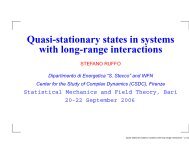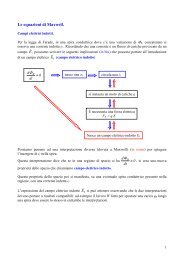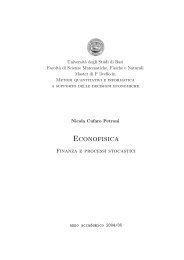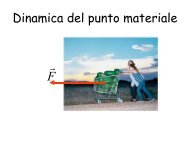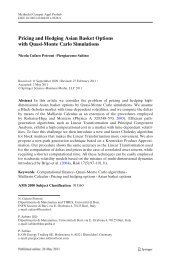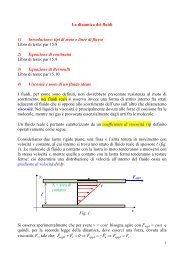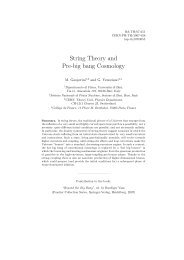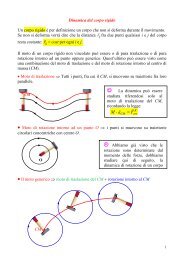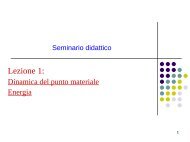Bulk viscosity of color-superconducting quark matter - Infn
Bulk viscosity of color-superconducting quark matter - Infn
Bulk viscosity of color-superconducting quark matter - Infn
Create successful ePaper yourself
Turn your PDF publications into a flip-book with our unique Google optimized e-Paper software.
Fedora GNU/Linux; L A TEX 2ǫ; xfig<br />
<strong>Bulk</strong> <strong>viscosity</strong> <strong>of</strong><br />
<strong>color</strong>-<strong>superconducting</strong> <strong>quark</strong> <strong>matter</strong><br />
Mark Alford<br />
Washington University<br />
Saint Louis, USA<br />
M. Alford, M. Braby, S. Reddy, T. Schäfer, nucl-th/0701067<br />
Reviews:<br />
M. Alford, K. Rajagopal, hep-ph/0606157<br />
T. Schäfer, hep-ph/0304281 K. Rajagopal, F. Wilczek, hep-ph/0011333
Color superconductivity: Cooper pairing <strong>of</strong> <strong>quark</strong>s<br />
At sufficiently high density and low temperature, there is a Fermi sea<br />
<strong>of</strong> almost free <strong>quark</strong>s.<br />
µ = E F<br />
E<br />
p<br />
F = E − µN<br />
But <strong>quark</strong>s have attractive<br />
QCD interactions.<br />
Any attractive <strong>quark</strong>-<strong>quark</strong> interaction causes pairing instability <strong>of</strong> the<br />
Fermi surface. This is the Bardeen-Cooper-Schrieffer (BCS)<br />
mechanism <strong>of</strong> superconductivity.<br />
BCS in <strong>quark</strong> <strong>matter</strong>: Ivanenko and Kurdgelaidze, Lett. Nuovo Cim. IIS1 13 (1969).
Color superconductivity in three flavor <strong>quark</strong> <strong>matter</strong><br />
p<br />
F<br />
Unpaired<br />
p<br />
F<br />
2SC pairing<br />
p<br />
F<br />
CFL pairing<br />
M s<br />
2<br />
4µ<br />
d<br />
u<br />
00000000000<br />
11111111111<br />
00000000000<br />
11111111111<br />
00000000000<br />
11111111111<br />
00000000000<br />
11111111111<br />
00000000000<br />
11111111111<br />
00000000000<br />
11111111111<br />
00000000000<br />
11111111111<br />
d<br />
u<br />
0000000000000000<br />
1111111111111111<br />
0000000000000000<br />
1111111111111111<br />
0000000000000000<br />
1111111111111111<br />
0000000000000000<br />
1111111111111111<br />
0000000000000000<br />
1111111111111111<br />
0000000000000000<br />
1111111111111111<br />
0000000000000000<br />
1111111111111111<br />
s<br />
s<br />
red<br />
green<br />
blue<br />
red<br />
green<br />
blue<br />
red<br />
green<br />
blue<br />
2SC: Two-flavor pairing phase. May occur at intermediate densities.<br />
〈qi α q β j 〉 ∼ ǫαβ3 ǫ ij i.e., (rg − gr)(ud − du)<br />
CFL: Color-flavor-locked phase, favored at the highest densities.<br />
〈qi α q β j 〉 ∼ δα i δ β j − δα j δ β i = ǫ αβN ǫ ijN<br />
(<strong>color</strong> α, β, flavor i, j = u, d, s); (Alford, Rajagopal, Wilczek, hep-ph/9804403)
I. High density QCD<br />
Conjectured phase diagram<br />
T<br />
60<br />
50<br />
heavy ion<br />
collider<br />
QGP<br />
T [MeV]<br />
40<br />
30<br />
20<br />
χSB<br />
NQ<br />
g2SC<br />
2SC<br />
guSC→<br />
uSC<br />
hadronic<br />
gas<br />
liq<br />
non−CFL<br />
CFL<br />
10<br />
CFL<br />
NQ<br />
←gCFL<br />
0<br />
320 340 360 380 400 420 440 460 480 500<br />
µ [MeV]<br />
80<br />
nuclear<br />
superfluid<br />
compact star<br />
µ<br />
70<br />
60<br />
50<br />
NQ<br />
↑g2SC<br />
uSC→<br />
guSC↓<br />
↑gCFL<br />
Right panels: NJL model<br />
with coupled chiral and <strong>color</strong><strong>superconducting</strong><br />
condensates.<br />
(Rüster, Werth, Buballa, Shovkovy, Rischke, hep-ph/0503184)<br />
T [MeV]<br />
40<br />
2SC<br />
30<br />
20 χSB<br />
CFL<br />
10<br />
0<br />
320 340 360 380 400 420 440 460 480 500<br />
µ [MeV]
Signatures <strong>of</strong> <strong>color</strong> superconductivity in compact stars<br />
Where in the universe is <strong>color</strong>-<strong>superconducting</strong> <strong>quark</strong> <strong>matter</strong> most<br />
likely to exist? In compact stars.<br />
A quick history <strong>of</strong> a compact star.<br />
A star <strong>of</strong> mass M 10M ⊙ burns Hydrogen by fusion, ending up with<br />
an Iron core. Core grows to Chandrasekhar mass, collapses ⇒<br />
supernova. Remnant is a compact star:<br />
mass radius density initial temp<br />
∼ 1.4M ⊙ O(10 km) ρ nuclear ∼ 30 MeV<br />
The star cools by neutrino emission for the first million years.
How would <strong>color</strong> superconductivity affect the star?<br />
{<br />
affects Equation <strong>of</strong> state. Hard to detect.<br />
Pairing energy<br />
Gaps in <strong>quark</strong> spectra<br />
and Goldstone bosons<br />
(Alford, Braby, Paris, Reddy, nucl-th/0411016)<br />
{ affect Transport properties:<br />
emissivity, heat capacity, <strong>viscosity</strong> (shear, bulk),<br />
conductivity (electrical, thermal). . .<br />
1. Cooling by neutrino emission, neutrino pulse at birth<br />
(Page, Prakash, Lattimer, Steiner, hep-ph/0005094; Carter and Reddy, hep-ph/0005228;<br />
Reddy, Sadzikowski, Tachibana, nucl-th/0306015; Grigorian, Blaschke, Voskresensky<br />
astro-ph/0411619).<br />
2. Glitches and crystalline (“LOFF”) pairing<br />
(Alford, Bowers, Rajagopal, hep-ph/0008208)<br />
3. Gravitational waves: r-mode instability, shear and bulk <strong>viscosity</strong><br />
(Madsen, astro-ph/9912418; Manuel, Dobado, Llanes-Estrada, hep-ph/0406058,<br />
Alford, Schmitt nucl-th/0608019, Alford, Braby, Reddy, Schäfer nucl-th/0701067,<br />
Manuel, Llanes-Estrada arXiv:0705.3909)
-modes: gravitational spin-down <strong>of</strong> compact stars<br />
An r-mode is a quadrupole flow that emits<br />
gravitational radiation. It becomes unstable<br />
(i.e. arises spontaneously) when a star<br />
spins fast enough, and if the shear and bulk<br />
<strong>viscosity</strong> are low enough.<br />
Polar view<br />
star<br />
mode pattern<br />
Side view<br />
The Lindblom group at Caltech has made a movie <strong>of</strong> r-mode evolution.<br />
http://www.cacr.caltech.edu/projects/hydrligo/rmode.html<br />
r-modes are unstable if rotation rate Ω > Ω crit (T), and they can spin<br />
the star down within months (Andersson gr-qc/9706075; Friedman and Morsink<br />
gr-qc/9706073; Lindblom astro-ph/0101136).<br />
Once we measure T and Ω for a star, we can put an upper limit on<br />
Ω crit (T).
Constraints from r-modes (Madsen, astro-ph/9912418)<br />
Predicted Ω crit (T) for various phases. Shaded regions above curves are<br />
unstable: <strong>viscosity</strong> is too low to hold back the r-modes.<br />
Nuclear <strong>matter</strong> Unpaired (m s = 200) 2SC (m s = 200)<br />
nuclear shear<br />
<strong>viscosity</strong><br />
damps r−modes<br />
0000000000<br />
1111111111<br />
0000000000<br />
1111111111<br />
0000000000<br />
1111111111<br />
0000000000<br />
1111111111<br />
0000000000<br />
1111111111<br />
0000000000<br />
1111111111<br />
0000000000<br />
1111111111<br />
0000000000<br />
1111111111<br />
0000000000<br />
1111111111<br />
0000000000<br />
1111111111<br />
0000000000<br />
1111111111<br />
0000000000<br />
1111111111<br />
0000000000<br />
1111111111<br />
0000000000<br />
1111111111<br />
0000000000<br />
1111111111<br />
0000000000<br />
1111111111<br />
0000000000<br />
1111111111<br />
0000000000<br />
1111111111<br />
0000000000<br />
1111111111<br />
0000000000<br />
1111111111<br />
ms<br />
0000000000<br />
1111111111<br />
0000000000<br />
1111111111<br />
0000000000<br />
1111111111<br />
0000000000<br />
1111111111<br />
0000000000<br />
1111111111<br />
LMXB<br />
nuclear<br />
bulk<br />
<strong>viscosity</strong><br />
damps<br />
r−modes<br />
000000000<br />
111111111<br />
000000000<br />
111111111<br />
000000000<br />
111111111<br />
000000000<br />
111111111<br />
000000000<br />
111111111<br />
000000000<br />
111111111<br />
000000000<br />
111111111<br />
000000000<br />
111111111<br />
000000000<br />
111111111<br />
000000000<br />
111111111<br />
000000000<br />
111111111<br />
000000000<br />
111111111<br />
000000000<br />
111111111<br />
000000000<br />
111111111<br />
000000000<br />
111111111<br />
000000000<br />
111111111<br />
000000000<br />
111111111<br />
000000000<br />
111111111<br />
000000000<br />
111111111<br />
000000000<br />
111111111<br />
000000000<br />
111111111<br />
000000000<br />
111111111<br />
000000000<br />
111111111<br />
000000000<br />
111111111<br />
000000000<br />
111111111<br />
000000000<br />
111111111<br />
unp shear<br />
<strong>viscosity</strong><br />
damps<br />
r−modes<br />
unp bulk<br />
<strong>viscosity</strong><br />
damps<br />
r−modes<br />
ms<br />
LMXB<br />
0000 1111<br />
0000 1111<br />
0000 1111<br />
0000 1111<br />
0000 1111<br />
0000 1111<br />
0000 1111<br />
0000 1111<br />
0000 1111<br />
0000 1111<br />
0000 1111<br />
0000 1111<br />
0000 1111<br />
0000 1111<br />
0000 1111<br />
0000 1111<br />
0000 1111<br />
0000 1111<br />
0000 1111<br />
0000 1111<br />
0000 1111<br />
0000 1111<br />
0000 1111<br />
0000 1111<br />
0000 1111<br />
0000 1111<br />
0000 1111<br />
0000 1111<br />
0000 1111<br />
0000 1111<br />
0000 1111<br />
0000000000<br />
1111111111<br />
0000000000<br />
1111111111<br />
0000000000<br />
1111111111<br />
0000000000<br />
1111111111<br />
0000000000<br />
1111111111<br />
0000000000<br />
1111111111<br />
0000000000<br />
1111111111<br />
0000000000<br />
1111111111<br />
0000000000<br />
1111111111<br />
0000000000<br />
1111111111<br />
0000000000<br />
1111111111<br />
0000000000<br />
1111111111<br />
0000000000<br />
1111111111<br />
0000000000<br />
1111111111<br />
0000000000<br />
1111111111<br />
0000000000<br />
1111111111<br />
0000000000<br />
1111111111<br />
0000000000<br />
1111111111<br />
0000000000<br />
1111111111<br />
0000000000<br />
1111111111 ms<br />
0000000000<br />
1111111111<br />
0000000000<br />
1111111111<br />
0000000000<br />
1111111111<br />
0000000000<br />
1111111111<br />
0000000000<br />
1111111111<br />
0000000000<br />
1111111111<br />
0000000000<br />
1111111111<br />
0000000000<br />
1111111111<br />
0000000000<br />
1111111111<br />
2SC shear<br />
<strong>viscosity</strong><br />
damps<br />
r−modes<br />
2SC bulk<br />
<strong>viscosity</strong><br />
damps<br />
r−modes<br />
LMXB<br />
00000 11111<br />
00000 11111<br />
00000 11111<br />
00000 11111<br />
00000 11111<br />
00000 11111<br />
00000 11111<br />
00000 11111<br />
00000 11111<br />
00000 11111<br />
00000 11111<br />
00000 11111<br />
00000 11111<br />
00000 11111<br />
00000 11111<br />
00000 11111<br />
00000 11111<br />
00000 11111<br />
00000 11111<br />
00000 11111<br />
00000 11111<br />
00000 11111<br />
00000 11111<br />
00000 11111<br />
00000 11111<br />
00000 11111<br />
00000 11111<br />
00000 11111<br />
00000 11111<br />
00000 11111<br />
00000 11111<br />
00000 11111<br />
00000 11111<br />
00000 11111<br />
00000 11111<br />
00000 11111<br />
Dotted lines: m s = 100 MeV; ms = millisecond pulsars<br />
According to Madsen’s original calculation, pairing always lowers bulk<br />
<strong>viscosity</strong>, making 2SC more vulnerable to r-modes.<br />
We find that actually ζ 2SC > ζ unp at high T. We expect this will move the<br />
Ω crit line outward (dark red arrows).
What is bulk <strong>viscosity</strong>?<br />
Energy consumed in a<br />
compression cycle:<br />
(L. viscum = mistletoe; It. vischio, Jp.℄<br />
Ô³£,<br />
Gm. Mistelzweig, Sp. muérdago, Fr. gui, Ru. omela)<br />
A sticky glue was made from mistletoe berries and<br />
coated onto small tree branches to catch birds.<br />
V (t) = ¯V + Re[δV exp(iωt)]<br />
p(t) = ¯p + Re[δp exp(iωt)]<br />
〈 dE<br />
dt<br />
〉<br />
= − ζ τ<br />
∫ τ<br />
0<br />
(div⃗v) 2 dt = ζ 2<br />
ω2<br />
δV<br />
2<br />
¯V 2 = − 1<br />
τ ¯V<br />
∫ τ<br />
0<br />
p(t) dV<br />
dt dt<br />
⇒ ζ(ω, T) = − ¯V<br />
δV<br />
Im(δp)<br />
ω<br />
Physically, bulk <strong>viscosity</strong> arises from re-equilibration processes. If some<br />
quantity goes out <strong>of</strong> equilibrium on compression, and re-equilibrates on a<br />
timescale comparable to τ, then pressure gets out <strong>of</strong> phase with volume and<br />
energy is consumed. (Just like V and Q in a R-C circuit.)
Flavor re-equilibration processes<br />
phase: 2SC CFL (not CFL-K 0 )<br />
lightest modes:<br />
unpaired (“blue”)<br />
<strong>quark</strong>s<br />
flavor equilibration: u + d ↔ s + u<br />
u<br />
d<br />
W<br />
s<br />
u<br />
H, K 0<br />
K 0 ↔ H H<br />
K 0 H ↔ H<br />
d<br />
s<br />
W<br />
u<br />
H
CFL thermal kaon bulk <strong>viscosity</strong><br />
(Alford, Braby, Reddy, Schäfer nucl-th/0701067)<br />
ζ (g cm -1 s -1 )<br />
10 28 _<br />
10 26 _<br />
10 24 _<br />
10 22 _<br />
10 20 _<br />
10 18 _<br />
10 16 _<br />
10 14 _<br />
10 12 _<br />
phonon<br />
m.f.p.<br />
greater<br />
than<br />
10 km<br />
µ = 400 MeV M s<br />
= 120 MeV τ = 1 ms<br />
δm = 1 MeV<br />
unpaired<br />
δm = 0.1 MeV<br />
δm = 10 MeV<br />
phonon splitting<br />
10 10 0.01<br />
_<br />
0.1 1 10<br />
T (MeV)<br />
K 0 dispersion relation:<br />
E(p) = − M2 s<br />
2µ + q<br />
1<br />
3 p2 + m 2 K 0<br />
≈<br />
m K 0 − M2 s<br />
+<br />
2µ<br />
| {z }<br />
δm<br />
1<br />
3 p2<br />
2m K 0<br />
Thermal kaon density ∼ exp(−δm/T),<br />
drops rapidly for T ≪ δm.<br />
Kaons dominate bulk <strong>viscosity</strong> for T δm/30.<br />
Superfluid mode (“phonon”) splitting dominates in some temp range if<br />
δm 2 MeV (Manuel, Llanes-Estrada arXiv:0705.3909)
How bulk <strong>viscosity</strong> depends on equilibration rate<br />
ζ(ω, T) = C(T)<br />
γ K (T)<br />
ζ<br />
C ω<br />
γ K (T) 2 + ω 2 1 2<br />
γ<br />
ω<br />
• ω is angular frequency <strong>of</strong> applied compression cycle.<br />
• C measures the sensitivity <strong>of</strong> n K and n q to changes in µ K and µ.<br />
• γ K is the average kaon width, from K 0 ↔ H.<br />
C<br />
Kaon Widths<br />
C (MeV 4 )<br />
10 6 _<br />
10 4 _<br />
10 2 _<br />
10 0 _<br />
10 -2 _<br />
10 -4 _<br />
µ = 400 MeV M s<br />
= 120 MeV<br />
δm = 0.5 MeV<br />
δm = 0.1 MeV<br />
δm = 1 MeV<br />
δm = 5 MeV<br />
δm = 10 MeV<br />
10 -6 0.01<br />
_<br />
0.1 1 10<br />
T (MeV)<br />
γ eff<br />
(MeV)<br />
10 -14 _<br />
δm = 10 MeV<br />
δm = 5 MeV<br />
10 -16 δm = 1 MeV<br />
_<br />
τ = 1 ms<br />
---------------------------------------------------------<br />
10 -18 _<br />
10 -20 _<br />
10 -22 _<br />
10 -24 _<br />
µ = 400 MeV M s<br />
= 120 MeV<br />
δm = 0.5 MeV<br />
δm = 0.1 MeV<br />
K + - δm = 1 MeV<br />
0.01 0.1 1 10<br />
T (MeV)
ζ (g cm -1 s -1 )<br />
10 30 _<br />
10 28 _<br />
10 26 _<br />
10 24 _<br />
10 22 _<br />
CFL kaonic bulk <strong>viscosity</strong>: dependence on ω<br />
<strong>Bulk</strong> Viscosity<br />
µ = 400 MeV M s<br />
= 120 MeV δm = 1 MeV<br />
unp<br />
τ = 1 ms<br />
τ = 5 ms<br />
τ = 10 ms<br />
CFL<br />
10 20 0.01<br />
_<br />
0.1 1 10<br />
T (MeV)<br />
As the frequency <strong>of</strong> compression drops,<br />
ζ(ω, T) = C(T)<br />
γ K (T)<br />
γ K (T) 2 + ω 2<br />
At high temp, γ K (T) rises, and ω<br />
becomes negligible.<br />
For unpaired <strong>quark</strong> <strong>matter</strong>, C is indp<br />
<strong>of</strong> T, and the resonance peak at<br />
γ K (T) = ω is clear.<br />
• The peak in ζ unp , which occurs where γ K (T) = ω, drops to lower<br />
temp.<br />
• The peak value rises: ζ max = 1 2 C/ω.
Quark <strong>matter</strong> bulk <strong>viscosity</strong>: Summary<br />
ζ (g cm -1 s -1 )<br />
10 28 _<br />
10 26 _<br />
10 24 _<br />
10 22 _<br />
10 20 _<br />
10 18 _<br />
10 16 _<br />
10 14 _<br />
10 12 _<br />
<strong>Bulk</strong> <strong>viscosity</strong> <strong>of</strong> <strong>quark</strong> <strong>matter</strong><br />
µ = 400 MeV M s<br />
= 120 MeV τ = 1 ms<br />
phonon<br />
m.f.p.<br />
greater<br />
than<br />
10 km<br />
δm = 1 MeV<br />
2SC<br />
unpaired<br />
δm = 0.1 MeV<br />
δm = 10 MeV<br />
(µ=500)<br />
CFL kaons<br />
CFL phonon splitting<br />
10 10 0.01<br />
_<br />
0.1 1 10<br />
T (MeV)<br />
Alford, Schmitt nucl-th/0608019; Alford, Braby,<br />
Reddy, Schäfer nucl-th/0701067;<br />
Manuel, Llanes-Estrada arXiv:0705.3909<br />
•Unpaired and 2SC have the<br />
largest bulk <strong>viscosity</strong>, because<br />
they have unpaired modes at<br />
Fermi surface (large phase space).<br />
•K 0 density ∼ exp(−δm/T)<br />
drops rapidly for T δm/10.<br />
•δm = m K 0 − Ms 2 /(2µ) could<br />
be anything from negative (kaon<br />
condensation) to ∼ 10 MeV.<br />
•Superfluid modes (“phonons”)<br />
alone contribute some bulk <strong>viscosity</strong>.
Looking to the future<br />
• Neutron-star phenomenology <strong>of</strong> <strong>color</strong> <strong>superconducting</strong> <strong>quark</strong><br />
<strong>matter</strong>:<br />
– shear and bulk <strong>viscosity</strong> <strong>of</strong> CFL-K 0 , other phases. . .<br />
– detailed analysis <strong>of</strong> r-mode pr<strong>of</strong>iles in hybrid star<br />
– heat capacity, conductivity and emissivity (neutrino cooling)<br />
– structure: nuclear-<strong>quark</strong> interface (gravitational waves?)<br />
– crystalline phase (glitches)<br />
– CFL: vortices but no flux tubes<br />
• More general questions:<br />
– magnetic instability <strong>of</strong> gapless phases<br />
– better weak-coupling calculations, include vertex corrections<br />
– go beyond mean-field, include fluctuations<br />
– solve the sign problem and do lattice QCD at high density.
Calculating bulk <strong>viscosity</strong> for a known equilibration rate<br />
Suppose the equilibrating quantity is n y (this will be n d − n s ).<br />
Corresponding chemical potential µ y = δµ y exp(iωt).<br />
We want Im(δp) = Im<br />
Write ṅ y two ways:<br />
(<br />
dp<br />
dµ y<br />
δµ y<br />
)<br />
= n y Im(δµ y ).<br />
dn y<br />
dµ y<br />
˙µ y = − ¯n y<br />
¯V ˙V − (n y − ¯n y )Γ<br />
⇒ dn y<br />
dµ y<br />
(iω + γ)δµ y = − ¯n y<br />
⇒ δµ y = −iω<br />
iω + γ ¯n y<br />
¯V iωδV<br />
( ) −1 dny δV<br />
dµ y<br />
¯V<br />
⇒ Im(δp) = ¯n y Im(δµ y ) =<br />
−ωγ δV<br />
ω 2 + γ 2 ¯V ¯n2 y<br />
{ equilibration<br />
rate is Γ<br />
writing Γ ≡ γ dn y<br />
dµ y<br />
( dny<br />
dµ y<br />
) −1<br />
⇒ ζ = − ¯V<br />
δV<br />
Im(δp)<br />
ω<br />
= ¯n 2 y<br />
( dny<br />
dµ y<br />
) −1<br />
γ<br />
γ 2 + ω 2



